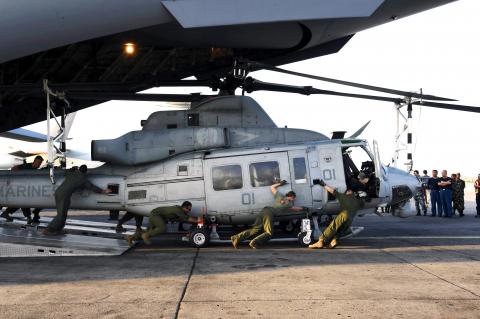The wreckage of a US military helicopter lost on an earthquake relief mission was found yesterday, high on a mountainside in Nepal, with three bodies recovered and the other five people on board feared dead.
A US search team identified the wreckage as that of the missing Marines UH-1Y Huey helicopter deployed after the Himalayan nation was hit by a massive earthquake last month that killed more than 8,000 people.
Crash debris was found just 13km north of the town of Charikot, said US Army Major Dave Eastburn, spokesman for the US military’s regional Pacific Command.

Photo: AFP
“The assessment of the site is ongoing and a thorough investigation will be conducted,” Eastburn said in a statement.
The statement made no mention of the fate of the six Marines and two Nepali soldiers onboard the Huey, which went missing on Tuesday, the day a strong aftershock hit Nepal and killed more than 100 people.
Nepal says none of the eight on board could have survived.
The Huey, an iconic helicopter dating back to the Vietnam War era, was completely destroyed, Nepalese Secretary of Defense Ishwori Prasad Paudyal said, adding that three charred bodies were found in the wreckage.
“The search for others is continuing,” Paudyal said. “As the helicopter has broken into pieces and totally crashed, there is no chance of any survivors.”
After a three-day search, the Huey was spotted near the village of Ghorthali at an altitude of 3,400m, Nepalese Major General Binoj Basnet told reporters earlier, while helicopters and Nepalese ground troops converged on the crash site.
“It was found on a steep slope,” Basnet said.
The area’s tallest peak soars to more than 7,000m. Hillsides are cloaked with lush forest that made it hard to find the chopper even though it came down just a few kilometers from Charikot, the capital of Dolakha District, which lies half a day’s drive to the east of Kathmandu.
An army base in the town has been serving as a hub for operations to airlift and treat those injured in the two earthquakes, and Nepalese Prime Minister Sushil Koirala flew in on Thursday for an on-the-spot briefing.
A magnitude 7.8 quake struck on April 25, killing 8,199 people. The death toll from a 7.3 aftershock on Tuesday has reached 117, with many of those killed in Dolakha.
The combined toll is approaching the number of just over 8,500 who died in an earthquake in 1934, the worst-ever natural disaster to hit the poor Himalayan nation.
About 76,000 others have been hurt, while hundreds of thousands of buildings — including ancient temples and monuments — have been damaged or destroyed.

LONG FLIGHT: The jets would be flown by US pilots, with Taiwanese copilots in the two-seat F-16D variant to help familiarize them with the aircraft, the source said The US is expected to fly 10 Lockheed Martin F-16C/D Block 70/72 jets to Taiwan over the coming months to fulfill a long-awaited order of 66 aircraft, a defense official said yesterday. Word that the first batch of the jets would be delivered soon was welcome news to Taiwan, which has become concerned about delays in the delivery of US arms amid rising military tensions with China. Speaking on condition of anonymity, the official said the initial tranche of the nation’s F-16s are rolling off assembly lines in the US and would be flown under their own power to Taiwan by way

OBJECTS AT SEA: Satellites with synthetic-aperture radar could aid in the detection of small Chinese boats attempting to illegally enter Taiwan, the space agency head said Taiwan aims to send the nation’s first low Earth orbit (LEO) satellite into space in 2027, while the first Formosat-8 and Formosat-9 spacecraft are to be launched in October and 2028 respectively, the National Science and Technology Council said yesterday. The council laid out its space development plan in a report reviewed by members of the legislature’s Education and Culture Committee. Six LEO satellites would be produced in the initial phase, with the first one, the B5G-1A, scheduled to be launched in 2027, the council said in the report. Regarding the second satellite, the B5G-1B, the government plans to work with private contractors

MISSION: The Indo-Pacific region is ‘the priority theater,’ where the task of deterrence extends across the entire region, including Taiwan, the US Pacific Fleet commander said The US Navy’s “mission of deterrence” in the Indo-Pacific theater applies to Taiwan, Pacific Fleet Commander Admiral Stephen Koehler told the South China Sea Conference on Tuesday. The conference, organized by the Center for Strategic and International Studies (CSIS), is an international platform for senior officials and experts from countries with security interests in the region. “The Pacific Fleet’s mission is to deter aggression across the Western Pacific, together with our allies and partners, and to prevail in combat if necessary, Koehler said in the event’s keynote speech. “That mission of deterrence applies regionwide — including the South China Sea and Taiwan,” he

‘NARWHAL’: The indigenous submarine completed its harbor acceptance test recently and is now under heavy guard as it undergoes tests in open waters, a source said The Hai Kun (海鯤), the nation’s first indigenous defense submarine, yesterday began sea trials, sailing out of the Port of Kaohsiung, a military source said. Also known as the “Narwhal,” the vessel departed from CSBC Corp, Taiwan’s (台灣國際造船) shipyard at about 8am, where it had been docked. More than 10 technicians and military personnel were on deck, with several others standing atop the sail. After recently completing its harbor acceptance test, the vessel has started a series of sea-based trials, including tests of its propulsion and navigational systems, while partially surfaced, the source said. The Hai Kun underwent tests in the port from